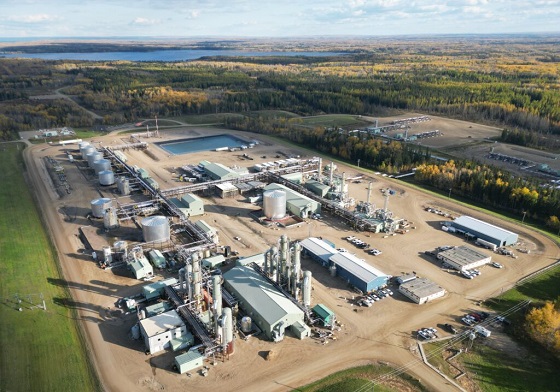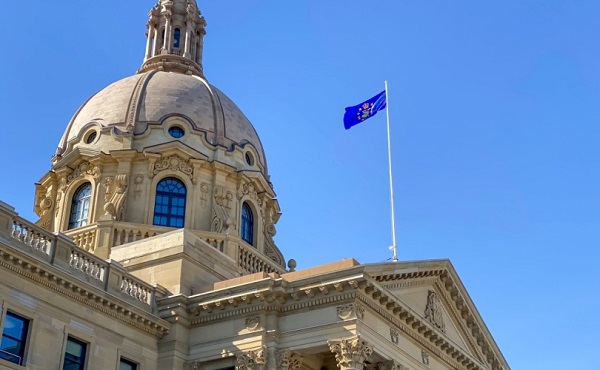Business
Government Subsidies and the Oil and Gas Industry

A look at Strathcona Resources Ltd.
Does the Canadian government subsidize companies operating in our oil and gas sector? According to research by science and technology journalist Emily Chung, between $4.5 billion and $81 billion of public funds are spent each year for assistance to the industry. But Chung notes how ambiguous definitions (what exactly is a subsidy?) mean that those numbers come with serious caveats.
I thought I’d make this discussion a bit more manageable by focusing on just one industry player: Strathcona Resources Ltd.
Strathcona is big. They produce around 185,000 barrels of oil equivalent each day and the company is currently ranked 98th among publicly traded companies in Canada in terms of market cap ($5 billion) and 88th for operating margin (21.59%).
The Audit does this work in part because paid subscribers share the load. Why not join, too?
What Is a Subsidy?
In the context of their report on the fossil fuel industry, the Department of Finance Canada asserts that “subsidies” can include:
- tax expenditures,
- grants and contributions,
- government loans or loan guarantees at favourable rates,
- resources sold by government at below-market rates
- research and development funding
- government intervention in markets to lower prices
The report defines tax expenditures as:
A type of tax measure, such as a preferential tax rate, exemption, deduction, deferral, or credit, with which the government aims to achieve public policy objectives through the tax system.
In the specific context of Strathcona, I could find no evidence that they’d received any direct public funding or “bailouts”. The government did recently announce a billion dollar partnership with the Canada Growth Fund (CGF) to build carbon capture and sequestration infrastructure, but that’s clearly an investment and not a subsidy. CGF is a Canadian arm’s-length crown corporation whose investments are managed by the Public Sector Pension Investment Board.
Strathcona’s 2023 Annual Report includes a reference to only one loan liability, but that had already been paid off and, in any case, wasn’t guaranteed by any level of government.
What Tax Benefits Does Strathcona Receive?
Many. The company’s annual report discusses its $6.1 billion “tax pool”. The pool is made up of deductions and credits that it can’t use this year, but that can be deferred for use in future years. Here’s how those break down:
The “Other Tax Deductions” item includes the Scientific Research and Experimental Development (SRED) deduction. That represents amounts spent on SRED-eligible research that companies can deduct from their payable taxes.
What Grant Funding Does Strathcona Receive?
Open Government data reports that only two federal grants were awarded to Strathcona, both in 2023. The first, worth $3.2 million, came from Natural Resources Canada as part of their Energy Innovation Program. Its purpose was development of Lindbergh Semi-Closed Cycle Flue Gas Recirculation and Carbon Capture.
The second grant was worth $12.5 million. It involved Environment and Climate Change Canada looking for an Orion Organic Rankine Cycle Waste Heat Recovery and Power Generation Project.
What Benefits Do Governments Receive From Strathcona?
Government subsidies don’t exist in a vacuum. As a rule, it’s assumed that subsidies to the private sector work as an investment whose primary payback is in profitable economic activity. Governments can also enjoy direct benefits.
In 2023, for example, Strathcona paid more than $405 million in crown royalties to provincial governments. They also spent $2.4 billion as operating expenses that included labor, energy costs, transportation, processing, and facility maintenance. Most of that money was spent in Canada.
A very rough estimate would suggest that total annual personal income taxes generated by people employed by Strathcona would be somewhere around $14 million. Vendors might pay another $13 million in corporate taxes.
There are also indirect benefits. For instance, those with jobs around the oil patch are, obviously, not unemployed and receiving EI benefits.
We could also take into account the larger impact Strathcona has on the general economy. Think about the food, shelter, clothing, and entertainment spending done by the families of Strathcona (and their vendors’) employees. That money, too, performs important social and economic service.
So does Strathcona receive more from government subsidies than the money they feed back into government accounts? Well, the $405 million in crown royalties are likely annual payments, as are the $27 million paid as income taxes. That’s what governments get. On the other side of the balance sheet, there is the $6.1 billion in deferred taxes and $16 million in grants. Those will probably be amortized over multiple years.
But does the word “subsidy” really describe tax benefits in any useful way? After all, there’s no company in all Canada – my own company included – that doesn’t deduct legitimate business expenses. And each and every Canadian receives similar benefits whenever they file their T1. For illustration, a Canadian whose total income happened to match the national average ($55,600) pays around $5,600 less in taxes each year due to various deductions and credits – including the basic personal amount.
Does that mean we’re all receiving government subsidies? There’s nothing wrong with thinking about it that way, but it does kind of strip the word of any real meaning.
Now you could reasonably argue that $6 billion is an awful lot of deferred tax, especially for a company with a 22% operating margin. And you could look to the tax code’s complexity for answers as to how this could have happened. But that’s not a subsidy in any coherent sense.
Think the tax code should be reformed? The line forms right behind me. However, the problem with playing around with the tax code is that changes apply to everyone, not just Strathcona or some other preferred target. Successfully anticipating how that might play out in dark and unanticipated ways isn’t the kind of thing for which governments are famous.
The Audit does this work in part because paid subscribers share the load. Why not join, too?
Business
Dallas mayor invites NYers to first ‘sanctuary city from socialism’

From The Center Square
By
After the self-described socialist Zohran Mamdani won the Democratic primary for mayor in New York, Dallas Mayor Eric Johnson invited New Yorkers and others to move to Dallas.
Mamdani has vowed to implement a wide range of tax increases on corporations and property and to “shift the tax burden” to “richer and whiter neighborhoods.”
New York businesses and individuals have already been relocating to states like Texas, which has no corporate or personal income taxes.
Johnson, a Black mayor and former Democrat, switched parties to become a Republican in 2023 after opposing a city council tax hike, The Center Square reported.
“Dear Concerned New York City Resident or Business Owner: Don’t panic,” Johnson said. “Just move to Dallas, where we strongly support our police, value our partners in the business community, embrace free markets, shun excessive regulation, and protect the American Dream!”
Fortune 500 companies and others in recent years continue to relocate their headquarters to Dallas; it’s also home to the new Texas Stock Exchange (TXSE). The TXSE will provide an alternative to the New York Stock Exchange and Nasdaq and there are already more finance professionals in Texas than in New York, TXSE Group Inc. founder and CEO James Lee argues.
From 2020-2023, the Dallas-Fort Worth-Arlington MSA reported the greatest percentage of growth in the country of 34%, The Center Square reported.
Johnson on Thursday continued his invitation to New Yorkers and others living in “socialist” sanctuary cities, saying on social media, “If your city is (or is about to be) a sanctuary for criminals, mayhem, job-killing regulations, and failed socialist experiments, I have a modest invitation for you: MOVE TO DALLAS. You can call us the nation’s first official ‘Sanctuary City from Socialism.’”
“We value free enterprise, law and order, and our first responders. Common sense and the American Dream still reside here. We have all your big-city comforts and conveniences without the suffocating vice grip of government bureaucrats.”
As many Democratic-led cities joined a movement to defund their police departments, Johnson prioritized police funding and supporting law and order.
“Back in the 1800s, people moving to Texas for greater opportunities would etch ‘GTT’ for ‘Gone to Texas’ on their doors moving to the Mexican colony of Tejas,” Johnson continued, referring to Americans who moved to the Mexican colony of Tejas to acquire land grants from the Mexican government.
“If you’re a New Yorker heading to Dallas, maybe try ‘GTD’ to let fellow lovers of law and order know where you’ve gone,” Johnson said.
Modern-day GTT movers, including a large number of New Yorkers, cite high personal income taxes, high property taxes, high costs of living, high crime, and other factors as their reasons for leaving their states and moving to Texas, according to multiple reports over the last few years.
In response to Johnson’s invitation, Gov. Greg Abbott said, “Dallas is the first self-declared “Sanctuary City from Socialism. The State of Texas will provide whatever support is needed to fulfill that mission.”
The governor has already been doing this by signing pro-business bills into law and awarding Texas Enterprise Grants to businesses that relocate or expand operations in Texas, many of which are doing so in the Dallas area.
“Texas truly is the Best State for Business and stands as a model for the nation,” Abbott said. “Freedom is a magnet, and Texas offers entrepreneurs and hardworking Texans the freedom to succeed. When choosing where to relocate or expand their businesses, more innovative industry leaders recognize the competitive advantages found only in Texas. The nation’s leading CEOs continually cite our pro-growth economic policies – with no corporate income tax and no personal income tax – along with our young, skilled, diverse, and growing workforce, easy access to global markets, robust infrastructure, and predictable business-friendly regulations.”
Business
National dental program likely more costly than advertised

From the Fraser Institute
By Matthew Lau
At the beginning of June, the Canadian Dental Care Plan expanded to include all eligible adults. To be eligible, you must: not have access to dental insurance, have filed your 2024 tax return in Canada, have an adjusted family net income under $90,000, and be a Canadian resident for tax purposes.
As a result, millions more Canadians will be able to access certain dental services at reduced—or no—out-of-pocket costs, as government shoves the costs onto the backs of taxpayers. The first half of the proposition, accessing services at reduced or no out-of-pocket costs, is always popular; the second half, paying higher taxes, is less so.
A Leger poll conducted in 2022 found 72 per cent of Canadians supported a national dental program for Canadians with family incomes up to $90,000—but when asked whether they would support the program if it’s paid for by an increase in the sales tax, support fell to 42 per cent. The taxpayer burden is considerable; when first announced two years ago, the estimated price tag was $13 billion over five years, and then $4.4 billion ongoing.
Already, there are signs the final cost to taxpayers will far exceed these estimates. Dr. Maneesh Jain, the immediate past-president of the Ontario Dental Association, has pointed out that according to Health Canada the average patient saved more than $850 in out-of-pocket costs in the program’s first year. However, the Trudeau government’s initial projections in the 2023 federal budget amounted to $280 per eligible Canadian per year.
Not all eligible Canadians will necessarily access dental services every year, but the massive gap between $850 and $280 suggests the initial price tag may well have understated taxpayer costs—a habit of the federal government, which over the past decade has routinely spent above its initial projections and consistently revises its spending estimates higher with each fiscal update.
To make matters worse there are also significant administrative costs. According to a story in Canadian Affairs, “Dental associations across Canada are flagging concerns with the plan’s structure and sustainability. They say the Canadian Dental Care Plan imposes significant administrative burdens on dentists, and that the majority of eligible patients are being denied care for complex dental treatments.”
Determining eligibility and coverage is a huge burden. Canadians must first apply through the government portal, then wait weeks for Sun Life (the insurer selected by the federal government) to confirm their eligibility and coverage. Unless dentists refuse to provide treatment until they have that confirmation, they or their staff must sometimes chase down patients after the fact for any co-pay or fees not covered.
Moreover, family income determines coverage eligibility, but even if patients are enrolled in the government program, dentists may not be able to access this information quickly. This leaves dentists in what Dr. Hans Herchen, president of the Alberta Dental Association, describes as the “very awkward spot” of having to verify their patients’ family income.
Dentists must also try to explain the program, which features high rejection rates, to patients. According to Dr. Anita Gartner, president of the British Columbia Dental Association, more than half of applications for complex treatment are rejected without explanation. This reduces trust in the government program.
Finally, the program creates “moral hazard” where people are encouraged to take riskier behaviour because they do not bear the full costs. For example, while we can significantly curtail tooth decay by diligent toothbrushing and flossing, people might be encouraged to neglect these activities if their dental services are paid by taxpayers instead of out-of-pocket. It’s a principle of basic economics that socializing costs will encourage people to incur higher costs than is really appropriate (see Canada’s health-care system).
At a projected ongoing cost of $4.4 billion to taxpayers, the newly expanded national dental program is already not cheap. Alas, not only may the true taxpayer cost be much higher than this initial projection, but like many other government initiatives, the dental program already seems to be more costly than initially advertised.
-

 Alberta12 hours ago
Alberta12 hours agoAlberta Independence Seekers Take First Step: Citizen Initiative Application Approved, Notice of Initiative Petition Issued
-

 Crime11 hours ago
Crime11 hours agoNational Health Care Fraud Takedown Results in 324 Defendants Charged in Connection with Over $14.6 Billion in Alleged Fraud
-

 Health10 hours ago
Health10 hours agoRFK Jr. Unloads Disturbing Vaccine Secrets on Tucker—And Surprises Everyone on Trump
-

 Bruce Dowbiggin13 hours ago
Bruce Dowbiggin13 hours agoThe Game That Let Canadians Forgive The Liberals — Again
-

 Alberta1 day ago
Alberta1 day agoCOVID mandates protester in Canada released on bail after over 2 years in jail
-

 Business1 day ago
Business1 day agoCanada’s loyalty to globalism is bleeding our economy dry
-

 Crime2 days ago
Crime2 days agoProject Sleeping Giant: Inside the Chinese Mercantile Machine Linking Beijing’s Underground Banks and the Sinaloa Cartel
-

 armed forces1 day ago
armed forces1 day agoCanada’s Military Can’t Be Fixed With Cash Alone










